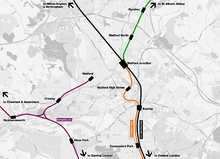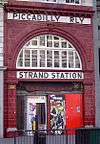Watford High Street railway station
| Watford High Street | |
|---|---|
|
| |
 Watford High Street Location of Watford High Street in Hertfordshire | |
| Location | Watford |
| Local authority | Borough of Watford |
| Managed by | London Overground |
| Owner | Network Rail |
| Station code | WFH |
| DfT category | D |
| Number of platforms | 2 |
| Fare zone | 8 |
| National Rail annual entry and exit | |
| 2009–10 |
|
| 2010–11 |
|
| 2011–12 |
|
| 2012–13 |
|
| 2013–14 |
|
| Key dates | |
| 1862 | Opened (W&RR) |
| 1917 | Started (Bakerloo line) |
| 1982 | Ended (Bakerloo line) |
| Other information | |
| Lists of stations | |
| External links | |
| WGS84 | 51°39′09″N 0°23′31″W / 51.652597°N 0.391812°WCoordinates: 51°39′09″N 0°23′31″W / 51.652597°N 0.391812°W |
|
| |
Watford High Street is a railway station in Watford, Hertfordshire, United Kingdom. It is served by the Watford DC Line on the London Overground network.
History

The station was opened by the Watford and Rickmansworth Railway (W&RR) on 1 October 1862, with services running from Watford Junction to Rickmansworth (Church Street). In 1912 a branch was opened to Croxley Green. The line came under the ownership of London and North Western Railway (LNWR), which was absorbed into the London, Midland and Scottish Railway (LMS) in 1923, following the grouping of Britain's railway companies.
Additional rail services were introduced to Watford High Street; in 1917 the Underground Electric Railways Company of London extended its Bakerloo line through this station to Watford Junction, and in 1922 the LNWR completed the suburban Camden to Watford Junction New Line, linking Watford High Street to London Euston via the Watford DC Line (shared with the Bakerloo line).
After nationalisation in 1948, the Watford DC Line was run by British Rail (from 1986 under its Network Southeast brand). At the height of operation around the 1950s, Watford High Street was served by the Bakerloo line, and by British Rail trains on both the Croxley Green and Rickmansworth branches, a local all-stations service to Euston and another local service to Broad Street via Primrose Hill.[2] Over the years, most of these services were gradually withdrawn. The Rickmansworth branch was a poorly used service and passenger services were terminated by BR in 1952. Croxley Green services continued as Parliamentary trains until the line closed fully in 1996.[3] In 1982 London Regional Transport cut back the Bakerloo line to run only as far north as Stonebridge Park (reinstating the service as far as Harrow & Wealdstone in 1984).[4] London Broad Street station was closed in 1986 and trains on the Primrose Hill route were diverted to Liverpool Street until 1992, when passenger services on the Primrose Hill line were withdrawn completely. After the withdrawal of the Croxley, Bakerloo and Broad Street routes, the only remaining service running from Watford High Street was British Rail's Watford DC Line to Euston.[2]
Following the privatisation of British Rail the franchise for the Watford DC Line was taken over by National Express Group who ran the line under its Silverlink Metro name. In 2007 the line was brought under the control of Transport for London, who today operate it as part of the London Overground network; this service uses the 750 V DC lines for its all-stations local service with the 4th rail presently redundant except as part of the electrical return circuit.
Location
Watford High Street station is located in the Lower High Street in Watford town centre. In the immediate vicinity around the station are a number of retail and civic amenities including the Watford Museum, containing a gallery of fine art and displays of local heritage, and the 1.4-million-square-foot (130,000 m2) intu Watford Shopping Centre (also known as the Harlequin Centre), the largest shopping centre in Hertfordshire, which attracts more than 17 million customers each year.[5] Various other shopping parks are also close to the station, including a large Tesco Extra, Waterfields Shopping Park (containing large stores such as Sports Direct and Next), as well as many stores situated on the High Street.
Watford town centre has many popular bars and clubs, such as Oceana; the only producing theatre in Hertfordshire, the Watford Palace Theatre; as well as numerous restaurants and cafes, both chain and independent.
To the east of the railway line is the site of Benskins Brewery, the office building for which is now Watford Museum. The brewery was rail-served by sidings until 1956.[6][7]
Services


All services to this station are operated by London Overground. It is on the Watford DC Line of the network and receives trains every 20 minutes Monday to Saturday daytimes; northbound and southbound. In evenings and on Sundays there is a half-hourly service in each direction.
| Preceding station | Following station | |||
|---|---|---|---|---|
Terminus | Watford DC Line | towards Euston |
||
| Historical railways | ||||
| Preceding station | Following station | |||
Terminus | Bakerloo line | towards Elephant & Castle |
||
| Disused railways | ||||
| |
||||
| Watford Junction | British Rail Rickmansworth Branch |
Rickmansworth (Church Street) | ||
| British Rail Croxley Green Branch |
Watford Stadium | |||
| Future routes | ||||
| Preceding station | Following station | |||
Terminus | Metropolitan line | |||
Connections
The station is served by Non London Bus Routes 8, 306, 306B, 306C, 398, 602, W19 and W20, as well as London Buses Routes 142, 258.
Other services to alternate destinations operate from Watford town centre bus stops, which are a short distance from the station.
Future

A project is under way to extend the London Underground's Metropolitan line to Watford Junction: the Croxley Rail Link will reinstate a stretch of the disused Watford and Rickmansworth Railway and divert the Metropolitan line branch across the town to join the Watford DC Line, sharing track with London Overground through Watford High Street to Watford Junction. The new route, expected to open in 2020,[8] will also provide two new Underground stations at Ascot Road and Vicarage Road. The project will bring about the return of London Underground trains to Watford High Street for the first time in 34 years, although the new service will be provided by the new Metropolitan line sub-surface trains rather than the deep-level Tube stock of the Bakerloo line. As a result of the diversion of the line, the original Watford tube station will close to passengers.[9]
References
- 1 2 3 4 5 "Station usage estimates". Rail statistics. Office of Rail Regulation. Please note: Some methodology may vary year on year.
- 1 2 "Watford High Street". Disused Stations. Subterranea Britannica. Archived from the original on 2013-07-19.
- ↑ "Watford to Croxley Green". West Watford History Group. Archived from the original on 2013-08-07.
- ↑ Rose, Douglas (1999). The London Underground : a Diagrammatic History (7th ed.). London: [The author]. ISBN 1854142194.
- ↑ "intu Watford - The centre". intu Group. Retrieved 17 November 2014.
- ↑ "Disused Stations: Rickmansworth Church Street". Disused Stations. Retrieved 30 November 2016.
- ↑ Catford, Nick. "Disused Stations: Watford High Street". Disused Stations. Retrieved 30 November 2016.
- ↑ "Croxley Rail Link update". 17 December 2014.
- ↑ "Croxley Rail Link". Transport for London. Archived from the original on 2013-03-25.
External links
| Wikimedia Commons has media related to Watford High Street railway station. |
- "Historical photographs of Watford High Street LNWR station". Photo archive. London Transport Museum. Archived from the original on 2013-08-11.
- Train times and station information for Watford High Street railway station from National Rail
